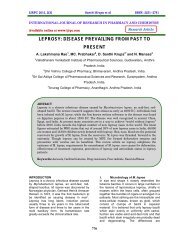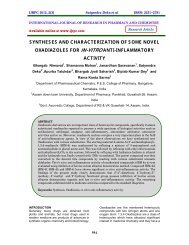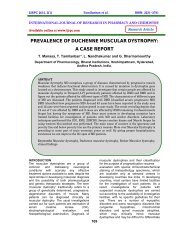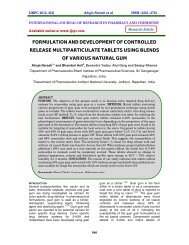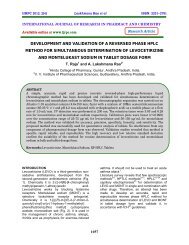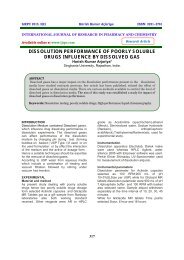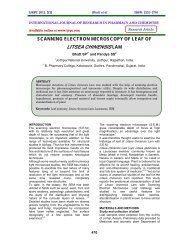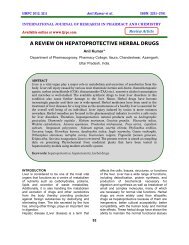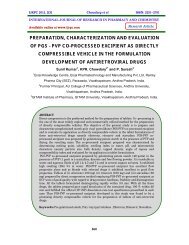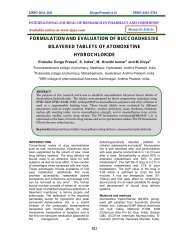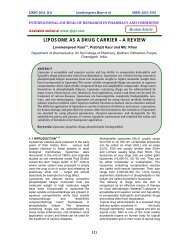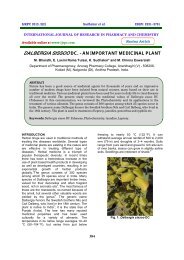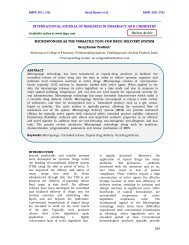microsatellite markers – a novel tool in molecular genetics - ijrpc
microsatellite markers – a novel tool in molecular genetics - ijrpc
microsatellite markers – a novel tool in molecular genetics - ijrpc
Create successful ePaper yourself
Turn your PDF publications into a flip-book with our unique Google optimized e-Paper software.
IJRPC 2012, 2(2) Pokhriyal et al ISSN: 22312781<br />
Homozygous<br />
(Both strands have 7 CT repeats)<br />
…CGTAGCCTTGCATCCTTCTCTCTCTCTCT<br />
CTATCGGTACTACGTGG…<br />
…CGTAGCCTTGCATCCTTCTCTCTCTCTCT<br />
CTATCGGTACTACGTGG…<br />
5’ flank<strong>in</strong>g region <strong>microsatellite</strong> locus 3’ flank<strong>in</strong>g region<br />
Heterozygous<br />
(One strand has 7 repeats, and the other has<br />
8 repeats)<br />
…CGTAGCCTTGCATCCTTCTCTCTCTCTCT<br />
CTATCGGTACTACGTGG…<br />
…CGTAGCCTTGCATCCTTCTCTCTCTCTCT<br />
CTCTATCGGTACTACGTGG…<br />
Microsatellites are useful genetic <strong>markers</strong><br />
because they tend to be highly polymorphic. It<br />
is not uncommon to have human<br />
<strong>microsatellite</strong>s with 20 or more alleles with<br />
heterozygosities. [8]<br />
Microsatellites generally tend to occur <strong>in</strong> noncod<strong>in</strong>g<br />
regions of the DNA although a few<br />
human genetic disorders are caused by (tr<strong>in</strong>ucleotide)<br />
<strong>microsatellite</strong> regions <strong>in</strong> cod<strong>in</strong>g<br />
regions. On each side of the repeat unit<br />
are flank<strong>in</strong>g regions that consist of "unordered"<br />
DNA. The flank<strong>in</strong>g regions are critical because<br />
they allow us to develop locus-specific primers<br />
to amplify the <strong>microsatellite</strong>s with PCR<br />
(polymerase cha<strong>in</strong> reaction). That is, given a<br />
stretch of unordered DNA 30-50 base pairs<br />
(bp) long, the probability of f<strong>in</strong>d<strong>in</strong>g that<br />
particular stretch more than once <strong>in</strong> the<br />
genome becomes vanish<strong>in</strong>gly small. This<br />
comb<strong>in</strong>ation of widely occurr<strong>in</strong>g repeat units<br />
and locus-specific flank<strong>in</strong>g regions are a part<br />
of strategy for f<strong>in</strong>d<strong>in</strong>g and develop<strong>in</strong>g<br />
<strong>microsatellite</strong> primers. The primers for PCR<br />
will be sequences from these unique flank<strong>in</strong>g<br />
regions. By hav<strong>in</strong>g a forward and a reverse<br />
primer on each side of the <strong>microsatellite</strong>, we<br />
will be able to amplify a fairly short (100 to 500<br />
bp, where bp means base pairs) locus-specific<br />
<strong>microsatellite</strong> region.<br />
There are two hypotheses that expla<strong>in</strong> how<br />
<strong>microsatellite</strong>s mutate 5<br />
1. “Polymerase slippage” or “slippedstrand<br />
mispair<strong>in</strong>g”: When the DNA<br />
replicates, the polymerase loses track of its<br />
place, and either leaves out repeat units or<br />
adds too many repeat units. The result is that<br />
the new strand has a different number of<br />
repeats as the parent strand. This is thought to<br />
expla<strong>in</strong> small changes <strong>in</strong> numbers of repeats.<br />
It also expla<strong>in</strong>s how <strong>microsatellite</strong> loci could be<br />
generated <strong>in</strong> the first place; it is likely that<br />
sequences <strong>in</strong>clud<strong>in</strong>g two or three repeats are<br />
randomly distributed throughout the<br />
genome. Slippage could then amplify these<br />
401<br />
short repeat sequences <strong>in</strong>to many repeats<br />
over successive generations. Certa<strong>in</strong>ly, the<br />
effectiveness of the mismatch repair system<br />
would also play an important role <strong>in</strong><br />
<strong>microsatellite</strong> mutation rate.<br />
2. Unequal cross<strong>in</strong>g-over dur<strong>in</strong>g<br />
meiosis:This is thought to expla<strong>in</strong> more<br />
drastic changes <strong>in</strong> numbers of repeats. In the<br />
diagram below, chromosome A obta<strong>in</strong>ed too<br />
many repeats dur<strong>in</strong>g cross<strong>in</strong>g-over and<br />
chromosome B obta<strong>in</strong>ed too few repeats. 9<br />
Model for Microsatellite Mutation 5<br />
Many models have been proposed to expla<strong>in</strong><br />
the mutation <strong>in</strong> <strong>microsatellite</strong>s but due to some<br />
or the other limitations or unexpla<strong>in</strong>ed facts<br />
they have been discarded. So a model is<br />
proposed which expla<strong>in</strong>s most of the<br />
mutational mechanisms and facts and<br />
uncerta<strong>in</strong>ties <strong>in</strong> <strong>microsatellite</strong> mutation are<br />
been described <strong>in</strong> stepwise mutation model as<br />
follows:<br />
Stepwise Mutation Model (SMM)<br />
The idea that add<strong>in</strong>g or subtract<strong>in</strong>g one repeat<br />
is likely easier than add<strong>in</strong>g or subtract<strong>in</strong>g two<br />
or more beads is the basis for us<strong>in</strong>g<br />
the Stepwise Mutation Model (SMM). This<br />
model holds that when <strong>microsatellite</strong>s mutate,<br />
they only ga<strong>in</strong> or lose one repeat. This implies<br />
that two alleles that differ by one repeat are<br />
more closely related (have a more recent<br />
common ancestor) than alleles that differ by<br />
many repeats. In other words, size matters<br />
when do<strong>in</strong>g statistical tests of population substructur<strong>in</strong>g.<br />
An advantage of the SMM is that<br />
the difference <strong>in</strong> size conveys additional<br />
<strong>in</strong>formation about the phylogeny of alleles. The<br />
SMM is generally the preferred model when<br />
calculat<strong>in</strong>g relatedness between <strong>in</strong>dividuals<br />
and population sub-structur<strong>in</strong>g, although there<br />
is the problem of homoplasy.<br />
Problem: Homoplasy<br />
Pretend that you are study<strong>in</strong>g a population and<br />
you f<strong>in</strong>d four <strong>in</strong>dividuals. Three of them have<br />
the same genotype, and one is different. This<br />
would <strong>in</strong>dicate that the three with the same<br />
genotype are more closely related to each<br />
other than they are to the other. However, this<br />
is not necessarily the case. To understand<br />
why, study the phylogeny below. Asterisks<br />
<strong>in</strong>dicate <strong>microsatellite</strong> mutations.



